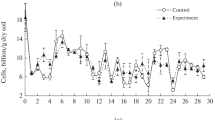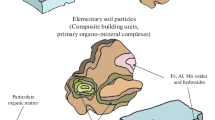Abstract
Microorganisms were detached and washed from soil by various procedures involving blending and sonication of the soil in water or pyrophosphate solution, followed by successive low-speed, centrifugal-washing separations of the suspended cells from the soil debris. Some of these procedures were previously used for separating and concentrating cells from soil for transmission electron microscopy viewing. Exhaustive applications of these procedures separated up to 27% of the platable cells from the soil. Based on filterability, these cells either were no longer attached to soil particles, or were attached to very small particles. The cells fractionating with the soil debris, however, seemed to be strongly attached to it or to other cells so that they were not filterable. Laboratory-grown cultures added to sterile and non-sterile soil did not attach to the soil materials and were easily recovered from the soil even though low-speed centrifugations were being used. Electron microscopy evidence for cells released and concentrated from non-inoculated natural soil, and for cells remaining with the soil debris, suggests that the very small, probably non-platable, cells tend to release more easily than do cells in the size range of 0.3 to 0.5 μm in diameter, and that cells larger than this, including bacterial and fungal spores, are more difficult to separate from soil. Plating data for heated preparations are in agreement with this for bacterial spores. The results are considered in relation to the validity of plate counts and direct soil transmission electron microscopy for evaluating the microbial flora of soil.
Similar content being viewed by others
References
Bae, H. C. andCasida, L. E., Jr. 1973. Responses of indigenous microorganisms to soil incubation as viewed by transmission electron microscopy of cell thin sections. J. Bacteriol.113: 1462–1473.
Bae, H. C., Cota-Robles, E. H. andCasida, L. E., Jr. 1972. Microflora of soil as viewed by transmission electron microscopy. Appl. Microbiol.23: 637–648.
Balkwill, D. L. andCasida, L. E., Jr. 1973. Microflora of soil as viewed by freeze-etching. -J. Bacteriol.114: 1319–1327.
Balkwill, D. L., Labeda, D. P. andCasida, L. E., Jr. 1975. Simplified procedures for releasing and concentrating microorganisms from soil for transmission electron microscopy viewing as thin-sectioned and frozen-etched preparations. -Can. J. Microbiol.21: 252–262.
Casida, L. E., Jr. 1965. Abundant microorganisms in soil. -Appl. Microbiol.13: 327–334.
Casida, L. E., Jr. 1969. Observation of microorganisms in soil and other natural habitats. Appl. Microbiol.18: 1065–1071.
Fränkel, C. 1887. Untersuchungen über das Vorkommen von Mikroorganismen in verschiedenen Bodenschichten. Z. Hygiene2: 521–582.
Hiltner, L. andStörmer, K. 1903. Studien über die Bakterienflora des Ackerbodens, mit besonderer Berücksichtigung ihres Verhaltens nach einer Behandlung mit Schwefelkohlenstoff und nach Brache. -Arb. Biol. NAbt. Land. Forstwirtschaft Kaiserlich. Gesundheitsamte3: 445–454.
Jones, D. andGriffiths, E. 1964. The use of thin soil sections for the study of soil microorganisms. Plant Soil20: 232–240.
Jones, P. C. T. andMollison, J. E. 1948. A technique for the quantitative estimation of soil micro-organisms. J. Gen. Microbiol.2: 54–69.
Kellenberger, E., Ryter, A. andSéchaud, J. 1958. Electron microscope study of DNA-containing plasms. 11. Vegetative and mature phage DNA as compared with normal bacterial nucleoids in different physiological states. -J. Biophys. Biochem. Cytol.4: 671–687.
Labeda, D. P., Balkwill, D. L. andCasida, L. E., Jr. 1975. Soil sterilization effects onin situ indigenous microbial cells in soil. Can. J. Microbiol.21: 263–269.
Reynolds, E. S. 1963. The use of lead citrate at high pH as an electron-opaque stain in electron microscopy. J. Cell Biol.17: 208–212.
Skinner, F. A., Jones, P. C. T. andMollison, J. E. 1952. A comparison of a direct- and a plate-counting technique for the quantitative estimation of soil micro-organisms. J. Gen. Microbiol.6: 261–271.
Spurr, A. R. 1969. A low-viscosity epoxy resin embedding medium for electron microscopy. J. Ultrastruct. Res.26: 31–43.
Stevenson, I. L. 1958. The effect of sonic vibration on the bacterial plate count of soil. Plant Soil10: 1–8.
Stotzky, G. 1972. Activity, ecology, and population dynamics of micro-organisms in soil. C.R.C. Crit. Rev. Microbiol.2: 59–137.
Strugger, S. 1948. Fluorescence microscope examination of bacteria in soil. Can. J. Res. C.26: 188–193.
Thornton, H. G. andGRAY, P. H. H. 1934. The numbers of bacterial cells in field soils, as estimated by the ratio method. Proc. Roy. Soc. (London)115: 522–543.
Waksman, S. A. 1922. Microbiological analysis of soil as an index of soil fertility: H. Methods of study of numbers of micro-organisms in the soil. Soil Sci.14: 283–298.
Zvyagintsev, D. G., Dmitriev, E. A. andGalkina, G. M. 1966. Effect of method of preparing soil for microbiological analysis on bacterial count. Microbiology35: 280–286.
Zvyagintsev, D. G. andGalkina, G. M. 1967. Ultrasonic treatment as a method for preparation of soils for microbiological analysis. Microbiology36: 910–916.
Zvyagintsev, D. G., Pertsovskaya, A. F., Dude, V. I. andNikitin, D. I. 1969. Electronmicroscopic study of the adsorption of micro-organisms on soil and minerals. Microbiology38: 937–942.
Author information
Authors and Affiliations
Additional information
This research was authorized for publication as paper no. 5131 in the journal series of the Pennsylvania Agricultural Experiment Station on 7/20/76.
Rights and permissions
About this article
Cite this article
Balkwill, D.L., Rucinsky, T.E. & Casida, L.E. Release of microorganisms from soil with respect to transmission electron microscopy viewing and plate counts. Antonie van Leeuwenhoek 43, 73–87 (1977). https://doi.org/10.1007/BF02316212
Received:
Issue Date:
DOI: https://doi.org/10.1007/BF02316212




